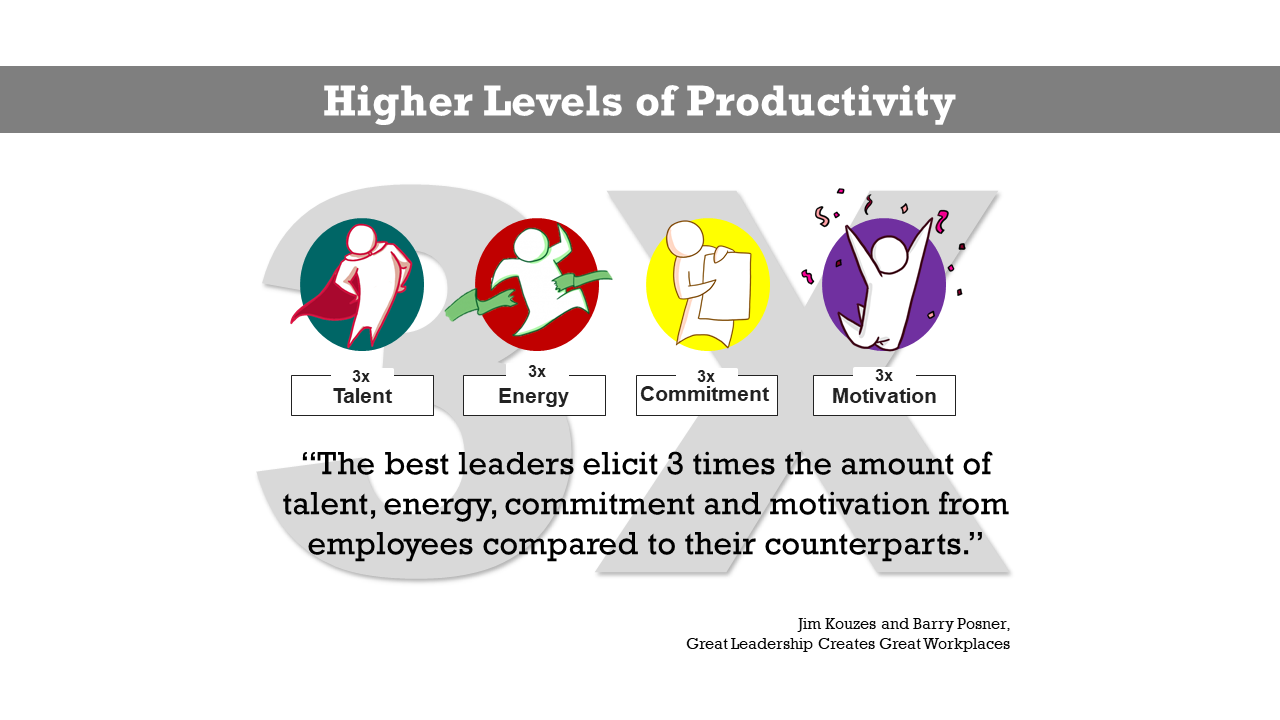Why Every Organization Needs Leaders at Every Level
 We’ve established that there’s a difference between leadership and management. Understanding that difference opens up opportunities for development in both management and leadership skills. It also liberates organizations to provide leadership development for leaders at every level, unbundled from any implied promise of promotion into management.
We’ve established that there’s a difference between leadership and management. Understanding that difference opens up opportunities for development in both management and leadership skills. It also liberates organizations to provide leadership development for leaders at every level, unbundled from any implied promise of promotion into management.
The strongest organizations are profitable, have high levels of employee engagement and low levels of turnover, and are prepared for sustainable, future growth. They have leaders at every level – some intentionally developed for expanded capacity in their current roles and some stretching to learn additional parts of the business in preparation for next-level roles. In fact, they strive to unleash the leadership potential of all employees.
Wait, What? Leadership Isn’t Just for the Folks at the Top of the Org Chart?
The folks at the top of the org chart are senior managers, aka as executives. They may (or may not) be leaders, regardless of their position, authority or title.
It’s become commonplace to call these folks “the leadership team” or “the senior leadership team.” Presumably, that elevated status is intended to differentiate the group from frontline managers, directors, VPs or others.
The main problem with conferring “leadership” status on any group is that it implies that leading is exclusively the domain of a small number of people at the top. It suggests that no one else is eligible to lead or guide others. It even sets up a dependency – all others in the organization must depend on the “leadership team” for vision, direction and guidance.
If it sounds like a surefire recipe for bottlenecks, inhibition of innovation, and stagnation… well, that’s because it is!
There’s another problem with making leadership exclusive. What happens when the group titled as “leaders” isn’t leading? It happens when they’re too mired in the day-to-day, too siloed, or too removed from the rest of the organization. It happens when they don’t fully understand what it really means to lead. Others in the organization see:
- Micromanaging and mistrust from the senior ranks
- Infighting and finger-pointing between senior executives as they defend their turf
- Elitism in attitude and treatment of others
- Decision-making that’s out-of-touch and ill-informed
- Lack of cohesiveness and shared vision
Not only do others see these destructive behaviors, but they also emulate them. The trickle-down effect of poor leadership at the top is no leadership anywhere. That’s confusing and uninspiring. It’s one of the primary reasons cited when employees are asked why they left an organization.
The best defense is a good offense. Encouraging leadership at every level delivers tons of benefits (see below) and creates accountability for good examples at the top.
Navy Commander and author L. David Marquet defines leadership at every level as “embedding the capacity for greatness in the people and practices of an organization, and decoupling it from the personality of the person at the top.”
This is what you’re aiming for by building leaders at every level. Throughout this CONNECT 2Lead series, we’re offering all the why’s and how’s so you can achieve this game-changing reset in your organization.
10 Compelling Reasons to Build Leadership throughout Your Organization
You can bank on these 10 outcomes when you build leadership at every level.
- Employee engagement levels will soar.
- Improved retention of the employees you want to retain and develop.
- Succession management is easier as you’re also building bench strength.
- Higher productivity rates.
- Customer satisfaction climbs.
- Increases in top-line revenue AND stronger profit margins.
- Enablement and ennoblement for all employees.
- Distributed decision-making (fewer meetings!).
- Reduced resistance to change.
- A culture of empowerment.
Let’s look more closely at these in in two categories.
The first six are intertwined and come together, part-and-parcel, with increases in employee engagement.
Employee engagement produces a domino effect of benefits, all backed by reams of research. When we say “employee engagement,” we’re referring to the widely accepted CEB definition:
Employee engagement is the emotional connection that employees feel toward the organization that causes them to apply additional discretionary effort to their work.
Of course, employees who feel emotionally connected are less likely to leave. That’s where you get improved rates of employee retention. When people stick around, you have better opportunities for development that prepare them for next-level roles. You get institutional knowledge and experience. It’s easier to promote from within. Succession management and internal promotions are less expensive than recruiting and onboarding unknowns.
Part two of employee engagement is the additional discretionary effort. It naturally leads to improved productivity – as measured by quantity and quality of output, reduced absenteeism, and less overtime.
Common sense reveals the rest of the equation. With longer-term employees and improved productivity, customers are more satisfied. They come back. They buy more. They recommend your products or services to others. Revenue increases. Expenses are reduced (less turnover means less recruiting and hiring costs + less overtime, etc.). Profit margins improve as revenue climbs and expenses are reduced.
All that goodness flows from increases in employee engagement. And, here’s the kicker: the top driver of employee engagement, without contest, is LEADERSHIP DEVELOPMENT.

The last four from the list are ways that leaders build engagement and directly yield the first six benefits. They are also stand-alone benefits, at least from the perspective of employees!
Enablement and ennoblement for all employees isn’t quite the same as empowerment. Enabling means that employees have the resources, tools, time and training needed for peak performance. Ennobling means that they have a sense of worth and importance placed on their work and contributions. To learn more about engagement, empowerment, enablement, and ennoblement, check out this recorded webinar about those 4 E’s.
Distributed decision-making is what reduces the amount of time spent in meetings. Instead of managers attending every meeting, the people closest to the work attend and participate in decision-making. Instead of back-and-forth, go-nowhere discussions, quality decisions are made with less friction.
Reduced resistance to change occurs when people feel heard and considered in decisions that affect them. Buy-in skyrockets when they’ve participated in creating the change and don’t feel ambushed by it.
When you put these pieces together, you get a culture of empowerment that:
- Inspires everyone to make an impact from wherever they are on the org chart.
- Includes distributed leadership (not management!) that’s routine and intentional.
- Equips individuals and organizations to face unprecedented levels of change and challenge.
- Ensures that everyone has the skills needed to quickly adapt, to engage meaningfully with their work, and to inspire one another .
To learn more about the reasons for building leaders at every level, join this free, fun, highly interactive workshop on People First Leadership Academy.
The Starting Point for Building Leaders at Every Level
Mindset is the starting point. Going through the motions performatively won’t convince employees that it’s real and that it’s safe. Getting buy-in from the top is important, but it doesn’t necessarily have to be the starting point. You can make believers by the proof of concept.
What’s the right mindset for leadership at every level? Here are the raw ingredients:
- People development is genuinely a priority. It’s not backburnered every time there’s a new business crisis. Rather, since challenge is the crucible of leadership, any crisis is viewed as an opportunity for people development and the emergence of leadership.
- Training for soft and transferable skills is valued and offered. Instead of “what have you done for me lately?” performance metrics alone, there are also “how have you grown recently?” conversations and expectations.
- When decisions are made, the people who will be affected are involved in the process. They are consulted and considered. They’re also conditioned to offer input and to ask questions. They aren’t shut down or excluded.
- Long-term vs. short-term thinking. When organizations hyper-focus on quarterly or monthly results, they lose sight of the bigger picture. They miss out on opportunities for learning, development, and innovation. They forget that the best way to build a business is by building the people (you know, the people who will build the business…).
- Commitment to giving control vs. taking control. Managers don’t hoard the power when it comes to decision-making, problem-solving or goal-setting. They dignify people by asking their opinions, trusting their judgment, and allowing them to work autonomously.
Mindsets become cultures. Cultures create passalong learning and permeate the day-to-day tasks, infusing them with meaning and reinforcing them. The more of these beliefs you have and activate, the more you’ll see in reciprocation. It gets easier and more natural over time.
Once you’ve got the mindset, you’ll need the skills and systems. We’ve got you covered in this series, so keep reading this CONNECT 2Lead series to get the full picture.
Looking for an immediate way to introduce leadership at every level in your organization? Check out Self Empowered™, a course designed specifically for leaders at every level.

